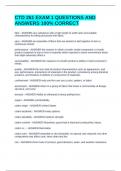CTD 261 EXAM 1 QUESTIONS AND
ANSWERS 100% CORRECT
fiber - ANSWER-any substance with a high length to width ratio and suitable
characteristics for being processed into fabric.
yarn - ANSWER-an assemble of fibers that are twisted or laid together to form a
continuous strand.
performance - ANSWER-the manner in which a textile, textile component, or textile
product responds to use or how it responds when exposed to some environment factor
that might adversely affect it.
serviceability - ANSWER-the measure of a textile product's ability to meet consumer's
needs.
quality - ANSWER-the sum total of product characteristics such as appearance, end
use, performance, interactions of materials in the product, consistency among identical
products, and freedom of defects in construction of materials.
confinement - ANSWER-only one firm can use a color, pattern, or fabric
assortment - ANSWER-refers to a group of fabric that share a commonality of design,
structure, and color.
tenacity - ANSWER-Ability to withstand a heavy pulling force.
regain - ANSWER-comfortability
cotton origin - ANSWER-United States
cotton aesthetic - ANSWER-many options
cotton durability - ANSWER-medium strength
cotton comfort - ANSWER-Absorbent, good heat & electrical conductivity; heavy.
cotton is... - ANSWER-flammable
cotton care - ANSWER-washable or dry-cleanable; no special care required, but other
components may affect care; store clean and dry.
coir - ANSWER-•from husk of coconut, good abrasion, water, and weather resistance.
, o Stiff, cinnamon brown color; good resistance to abrasion, water, and weather; wiry
texture.
o floor textiles (rugs, doormats, and tile)
kapok - ANSWER-from seed of Java kapok or silk cotton.
o Lightweight, soft, hollow, buoyant, poor aging resistance.
o Uses: fiberfill in lifejackets, pillows, padding
milkweed - ANSWER-fiberfill in comforters, personal flotation devices, and upholstery.
flax - ANSWER-Bast fiber: Irregular fibers from stem of the plant; process includes
retting, scotching, and hackling; may be cottonized or cut to a length similar to that of
cotton fiber to facilitate blending with cotton and processing on cotton equipment.
linen - ANSWER-100% flax
ramie - ANSWER-• Bast fiber, sometimes called "China grass".
• Imported from Asia, usually in fabric or apparel form.
• Reintroduced in past years because there were no import quotas on it, but used in
China for thousands of years.
• Often found blended with cotton; hard to distinguish from cotton in hand
• White long fine fiber with luster
jute - ANSWER-• Bast fiber, used un BURLAP.
• Imported from India, Pakistan, and Bangladesh.
• Formerly used in carpet backing.
• Cheap
• Brown, weak, brittle, poor elongation
• Poor colorfastness
hemp - ANSWER-• Mainly used in ropes, twine, and cordage.
• Some interest in this as alternative fiber for clothing
• Not pliable or elastic
kenaf - ANSWER-• Plant of Central Asia, India, Africa, and Central America
• Long fiber twine, cordage
bamboo - ANSWER-• Mechanically processed to get bast fibers
• Antimicrobial
• No pesticides or fertilizer needed
• Grows rapidly
• Can also be used in a man-made fiber
leaf fibers - ANSWER-• Long and fairly stiff, poor dye affinity, natural colors
• Leaf cut from plant and fiber split or pulled from leaf.




